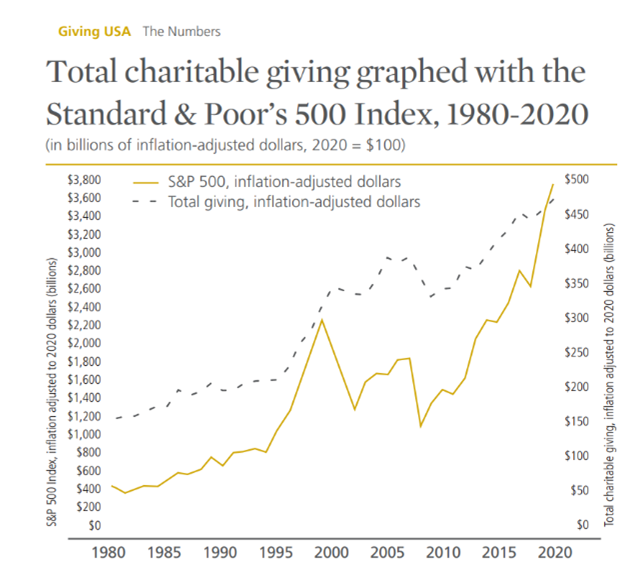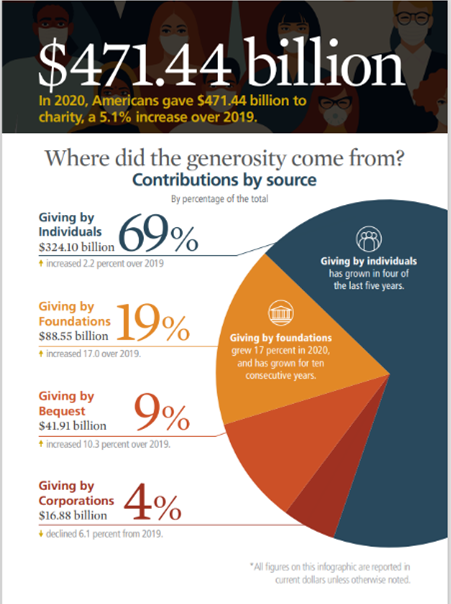By Jessica Browning, Principal and EVP at Winkler Group
The last two years have been anything but predictable. Will 2022 be another aberration or will we return to pre-pandemic trends in giving?
Below are nine trends we expect to shape philanthropy in the coming year, and how we will advise our clients to leverage them.
A Bullish 2022
We’re predicting giving to be strong in 2022 because the stock market is expected to keep growing. In December, JP Morgan, Wells Fargo, and Goldman Sachs all predicted the S&P would reach above 5,000 at the end of 2022 (the S&P was at 4,686 on December 7, 2021) (Klebnikov, 2021). Because philanthropic giving is highly correlated to the strength of the stock market as seen in this graph from Giving USA, we anticipate a robust year of giving ahead.

Another positive indicator is last month’s GivingTuesday 2021, which raised $2.7 billion—a six percent increase over 2020. The number of donors also rose—up six percent over last year’s already high numbers (Hanyes & Stiffman, 2021).
Will the Endowment Fervor Last?
Motivating donors to fund an endowment is often a challenge, or at least it used to be. In the many campaign studies we have conducted over the last two years, we’ve seen a noticeable shift.
The pandemic instilled in donors a sense of responsibility and sustainability. Endowments that were once an afterthought are now at the top of donors’ priority lists. Donors recognize the fragility of the organizations and institutions they support; they want to ensure their favorite causes can weather the next pandemic or catastrophe.
Our team is split on whether the interest in endowment will last for the long-term. We hope it will, but we also recognize that it is up to all of us to continue to make the case for financial sustainability alongside the need to advance our missions.
Demand for Campaigns Will Continue to be Strong
Organizations and institutions that postponed a campaign in 2020 and again in 2021 will finally take the plunge. The need for new facilities, new programs, and larger endowments has not subsided. And nonprofits are recognizing the external factors that are likely to encourage large campaign gifts in 2022.
Last December, we dubbed 2021 the Year of the Transformational Gift—and 2021 did not disappoint. We saw more seven-figure gifts made to campaigns in 2021 than during any other year in the Winkler Group’s nearly 20-year history. Given the stock market’s expected growth and the trend towards ever-larger gifts, we expect 2022 to be another landmark year for campaign success.
Shorter Strategic Plans
Five-year strategic plans have been the standard, but we expect the shift towards shorter timelines to continue. The pandemic underscored the importance of being nimble. As a result, institutions and organizations have been adopting strategic plans with shorter timelines—some as short as two years. We expect this trend to continue in 2022 and beyond.
There are many benefits to a shorter strategic plan. For nonprofits, a shorter timeline means more opportunities to engage key stakeholders in the plan’s drafting and execution. A shorter span also creates a sense of urgency—and increases the likelihood that the plan will be fully implemented.
Congress Won’t Act
As much as we hate to make this prediction, we do not foresee Congress making any advances in passing permanent legislation to encourage philanthropy through tax breaks.
The tax breaks for giving that Congress enacted during the pandemic will expire and will not be renewed. This means that the cap on deductions will revert to 60 percent of adjusted gross income and the $300 limit for individuals to deduct donations will disappear. There does not appear to be support for a “universal” deduction among lawmakers, at least in 2022.
Fewer Donors, Larger Gifts
There is nothing new about this trend. We have seen a consolidation of giving since 2008 and don’t expect major changes in 2022.
We do expect to see the continued erosion of mid-level giving that resulted from the 2017 American Tax Cuts and Jobs Act. By increasing the standard deduction from $6,500 to $12,000 for individual filers ($12,550 in 2021 after being indexed for inflation) and raising the limit on deductions from 50 percent to 60 percent of AGI, the monetary incentive for charitable gifts from all but the wealthiest Americans was eliminated.
As fundraising professionals, it’s important for us to make the case for philanthropic growth at all giving levels. The focus on donor retention should be intensified, so lower-level donors have an opportunity to mature into mid-level and then major gift donors. Above all, we must treat donors as investors and continue to demonstrate the impact they make through their charitable gifts.
Increased Corporate Engagement, Not Necessarily Philanthropy
Corporate giving is complex and extends beyond altruism to goodwill, marketing, and overcoming negative publicity.
As diversity and social justice issues continue to gain momentum, we expect to see more corporations align themselves with related organizations. Because younger Americans are more cause-focused, we believe this alignment will be strongest among corporations trying to appeal to Gen Z and Millennials.
There is a lot of good that can come of strategic corporate/nonprofit partnerships. For example, corporations that support workforce development programs through local colleges benefit from a higher skilled workforce. Encouraging workplace volunteer programs builds a stronger culture among employees. Organizations and institutions that recognize these natural synergies should capitalize on them.
However, the majority of giving in the United States will continue to be from individuals (78 percent of all giving including bequests in 2020); only 4 percent of all giving came from corporations. In 2020 corporations gave less than 1 percent (0.8 percent) of pre-tax profits to charities. Public corporations are justifiably accountable to their shareholders—and to quarterly earnings reports. This will not change, so a fundraiser’s time will continue to be best spent building relationships with individual donors.

Source: Giving USA 2020
A Heightened Focus on Performance Ratios
ProPublica’s investigative report into St. Jude last month was eye-opening (Armstong & Gabrielson, 2021). The hospital raised $2 billion in 2020, ranking them third on the Chronicle of Philanthropy’s list of America’s Favorite Charities (2021). But only half of what St. Jude raised over the last five years went to research or patient care. Thirty percent went to cover fundraising costs. Allocations like these cast doubt in donors’ minds about the true impact of their gift.
But spending too little on staff and fundraising expenses can be as dangerous as spending too much. Cultivating and stewarding the donor relationships that result in sustainable funding takes resources; good nonprofit executives and fundraisers should be well compensated to retain top talent.
We are often asked about ideal program expense and fundraising efficiency ratios. While it depends on the organization, we suggest a target program expense ratio of 85 percent and fundraising costs that equate to between $0.05-$0.10 of every dollar raised. The pandemic skewed those ratios for 2020 and 2021, particularly among organizations that received significant government funding. For 2022, however, we expect these ratios to stabilize.
We encourage nonprofit leaders need to educate their boards about the numbers behind these ratios. It can be dangerous for board members to insist, for example, that an organization maintain a 95 percent program expense ratio—or spend as little as possible on fundraising resources.
DAFs Will Continue their Meteoric Rise
Last month, the Giving USA Foundation published a landmark look at gifts made from donor advised funds between 2014 and 2018 (2021). The report found that the value of assets in DAFs grew from $31.1 billion in 2006 to $141.95 billion in 2019. Those values will continue to climb, driven by DAFs’ popularity among donors and a financial incentive to promote them by firms like Vanguard and Fidelity.
DAFs will also continue to change the way we give and who receives our gifts. The Special Report on Donor Advised Funds found that education and the arts received the most DAF grants (29 percent). However, in terms of total U.S. giving, religion received the biggest percentage but a far smaller percentage of total DAF gifts (31 percent of total US philanthropic giving between 2014 and 2018 but only 14 percent of DAF gifts made during the same period.) As the percentage of total gifts made from DAFs increase, fundraisers from all sectors must recognize the change in giving patterns.
We do not anticipate that the bipartisan legislation introduced in 2021 by Senators Angus King and Chuck Grassley will gain traction and force quicker DAF disbursements. The debate over whether forced DAF payouts will help or hurt community foundations will continue. We anticipate the #HalfMyDAF movement to gain momentum but whether it will make an impact is uncertain. What is certain is that DAFs will continue to pose both challenges and opportunities for fundraising professionals.
Author:
Jessica Browning is Principal and Executive Vice President of the Winkler Group, a national capital campaign and strategic planning firm headquartered in Charleston, South Carolina. A former member of the Giving USA Editorial Review Board, Jessica has a B.A. from Duke University and an M.B.A. and M.A. from the College of William & Mary.
Bibliography
Armstrong, D., & Gabrielson, R. (2021, November 12). St. Jude hoards billions while many of its families drain their savings. ProPublica. https://www.propublica.org/article/st-jude-hoards-billions-while-many-of-its-families-drain-their-savings
Haynes, E., & Stiffman, E. (2021, December 2). GivingTuesday raises estimated $2.7 billion from americans, a 9% rise. The Chronicle of Philanthropy. https://www.philanthropy.com/article/givingtuesday-raises-estimated-2-7-billion-from-americans-a-9-rise?utm_source=Iterable&utm_medium=email&utm_campaign=campaign_3307381_nl_Philanthropy-Today_date_20211202&cid=pt&source=&sourceid=&cid2=gen_login_refresh
Indiana University Lilly Family School of Philanthropy. (2021, November). Giving USA special report, donor-advised funds: New insights. Giving USA Foundation. https://givingusa.org/
Klebnikov, S. (2021, December 1). Here’s what wall street’s biggest banks predict for stocks in 2022—and what to watch for. Forbes. https://www.forbes.com/sites/sergeiklebnikov/2021/12/01/heres-what-wall-streets-biggest-banks-predict-for-stocks-in-2022-and-what-to-watch-for/?sh=5d6698416b31
The Chronicle of Philanthropy. (2021, November 2). America’s favorite charities 2021. https://www.philanthropy.com/article/americas-favorite-charities-2021



